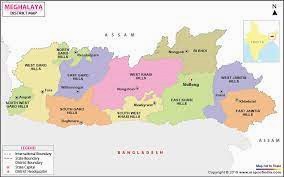
Meghalaya (Abode of the Clouds) is also known as the ‘Scotland of the East’ for its scenic magnificence. Having spent two best years of my life I can vouch for it.
Meghalaya emerged as an autonomous State on April 2, 1970, and was declared a State of the Indian Union on January 1, 1972. Prior to April 1970, Meghalaya was a part of the composite State of Assam.

It is home to many tribes:-
- The Garos (Achiks as they call themselves) belong to the Tibeto-Burman race and dominate western Meghalaya. The Garos are situated on the Garo Hills and scattered across Assam, Tripura, Nagaland and the Mymensingh District in Bangladesh, and constitute 34.06% of the tribal population.
- The Khasis, central Meghalaya. Khasis constitute the tribal majority with 56.04% of the tribal population, thus benefitting from the systems of resource distribution undertaken by the state government.
- The Jaintias from eastern Meghalaya.
- The ‘Hynniewtrep’ people, a collective name of the Khasi, Jaintia, Bhoi and War tribes belonging to the Proto-Austroloid Monkhmer race, primarily dominate Eastern Meghalaya.
Unrest and Violence
The State has been plagued with the problem of insurgency since the latter part of the 1980s. The reasons of discord and violence in Meghalaya are mainly:
- Divide between the locals and non-locals, and issues of identity.
- Differing Aspirations and Inter-tribe rivalry.
- Growing corruption and perceived injustice by tribes.
Porous Borders. One of the primary reasons behind the continued insurgency in Meghalaya is the porous border with Bangladesh, which has not only made easier the illegal migration of Bangladeshis but has also allowed the militant outfits to be based out of the latter. For years, tribal leaders and the student unions of the respective tribes have demanded the deportation of illegal Bangladeshi immigrants and the institution of the Inner Line Permit system. Of the 443 km-long border between Meghalaya and Bangladesh, 350 km is fenced. The mountainous terrain and the thick forest cover between Meghalaya and Bangladesh is an ideal place for smuggling of arms and narcotics.
Locals & Non-locals divide. The divide among tribal residents of the State and the non-tribal settlers (mostly Bangladeshis) has been a prime factor for the growing discontent. Commencing with the divide that persisted through the nineteen seventies and eighties. The situation flared up in August 1992, when the Khasi Students’ Union (KSU) and the Federation of Khasis, Jaintia, and Garo Peoples (FKJGP) started issuing threats to non-tribal traders, compelling them to shut down their businesses in Meghalaya for not possessing valid trading licenses. A riot – widely considered the fifth major riot against the so-called outsiders followed, claiming 31 lives. In 1994, another round of trouble ensued over the Election Commission’s orders for preparing photo-identity cards for all voters, which was resisted by the KSU. The KSU insisted that no photography for the cards would be permitted before the electoral rolls were revised with a 1951 cut-off date with regard to immigrants.
Differing Tribal Aspirations. Meghalaya is essentially a tribal-majority state. The majority tribes demand a separate Khasi and Garo state respectively to be carved out of Meghalaya, there are also conceptions of perceived injustice by the Indian government on favouring one tribe over the other.
Governance Issues. Overall too, the tribal groups believe that the government has been ineffective at ensuring high rates of socio-economic development in the region. When the state was formed, the central government had instituted three Autonomous District Councils (ADCs) in the state: the Garo Hills Autonomous District Council at Tura, the Khasi Hills Autonomous District Council at Shillong and the Jaintia Hills Autonomous District Council at Jowai – all of which have been largely ineffective over the years in being accountable to aspirations of the tribal communities. Development projects in Meghalaya have been slow in approval and implementation.
Coal Mining. Another factor complicating the stability of the state is the illegal coal mining that has continued largely unabated. Practiced through long, narrow tunnels by locals it is termed as ‘rat-hole mining’. These exist in the East Jaintia Hills and the West Khasi Hills. In these areas, the banned groups continue to extort mining sites along with their armed cadres, becoming an easy source of funding for them. Further, these unscientific mining methods pose serious threats to the environment, lead to a reduction of forest cover, increase soil erosion, injure bio-diversity, and cause air, water, and land pollution.
Groups Operating in Meghalaya.
Hynniewtrep National Liberation Council (HNLC). Active in the Khasi Hills of the State, since 1992 – aims at creating a sovereign State for the Khasis. According to the HNLC’s 19-point manifesto, the organization stands for the “national existence and self-determination of our people without subordination under the yoke of foreign powers”. Its objectives include the transformation of Meghalaya into a ‘Khasi State’ and freedom from the domination of the Garo tribes. Further, it also aims at fighting ‘outsiders’, as the group sees Khasi youth as a deprived lot in their own land. Its activities include, among others, fake currency circulation in the State, as well as extortion and other forms of underground activities, primarily for monetary gains.
Achik National Volunteer Council (ANVC). Formed in December 1995 – aims to carve out a homeland called ‘Achik Land’ in the area of the Garo Hills. The ANVC demands a homeland for the Achiks (Garos) comprising the Garo Hill District of Meghalaya, the Garo-dominated Nongkhlaw area in the Khasi Hills, and the Garo-Inhabited Goalpara and Kamrup districts of Assam. The ANVC also established an ‘extortion empire’ of sorts in the Garo Hills and parts of the West Khasi Hills. In 2004 a cease-fire agreement was signed between Govt of India and ANVC. The agreement has been periodically extended and monitored by a ceasefire monitoring cell. Two camps in the Garo Hill region house the members of the group.
People’s Liberation Front of Meghalaya (PLF-M). The People’s Liberation Front of Meghalaya (PLFM) operating in the Garo Hills of Meghalaya, since 1995. It is an offshoot of the Achik Liberation Matgrik Army (ALMA). Reports also suggest that the outfit had been re-christened as the Achik National Council (ANC) on August 2001. The primary objective of the PLFM is economic development as well as better educational opportunities for the Garo tribes in Meghalaya. One of its claimed objectives is also a demand for a separate Garo State.
Garo National Liberation Army. This group was formed in 2009. It has been involved in killing, abduction, extortion, and attack on security forces. It is fighting for a sovereign Garo land in western Meghalaya.
External Links
The HNLC is understood to have close links with the National Socialist Council of Nagaland – Isak-Muivah (NSCN-IM) faction. It is also believed that the Inter-Services Intelligence (ISI), Pakistan’s external intelligence agency, has assisted the HNLC in the acquisition and circulation of fake currency.
Over the years, the ANVC has come to establish a working relationship with the National Democratic Front of Bodoland (NDFB), and the United Liberation Front of Asom (ULFA), both groups continue to assist each other in several operations.
GNLA has close operational links with other NE based groups like ULFA, NDFBand NSCN-IM. It has also forged alliances with Bangladesh based groups.
Peace Initiatives
The State Government has made repeated appeals for negotiated settlements. However, the insurgent groups, accuse the political establishment of a ‘lack of sincerity’ towards solving contentious issues.
Political instability in the State is another factor in the failure to resolve the insurgency problem. Successive Governments have their own approach, with a lack of consistency in their approach.
The Church leaders, under the banner of Shillong Khasi Jaintia Church Leaders’ Forum (SKJCL), had offered their services to the State Government to initiate talks with terrorist groups, especially the HNLC.
State Government had formed SF-10, an elite commando force in Oct 2016, to deal with the insurgency. Since then they have been involved in numerous operations with claims of a high success rate, inflicting heavy toll on group cadres and their leaders.
Prevailing Situation.
The overall situation in the Garo Hills Districts (except for a few pockets) has improved. However, some groups are still involved with undesirable activities.
The security situation in Meghalaya has improved considerably, but a decisive end to its multiple insurgencies has still not been achieved and some areas of concern remain.
Way Ahead
- Sustained effort by the state government with continuity of policy.
- Accelerated development projects – decision and implementation.
- Engaging the tribal groups with sincerity of effort.
- Addressing the tribal concerns genuinely.
- Center-state rapid response mechanism.
- Measures to prevent illegal migration.
- Addressing the issue of illegal mining.
- Measures to stop smuggling.
- Encouraging establishment of local tribal, state and national identity.
Suggestions and value additions are most welcome
For regular updates, please register here
References:
References and credits
To all the online sites and channels.
Disclaimer:
Information and data included in the blog are for educational & non-commercial purposes only and have been carefully adapted, excerpted, or edited from sources deemed reliable and accurate. All copyrighted material belongs to respective owners and is provided only for purposes of wider dissemination.

A land of rolling hills and misty mountains , it’s true wonder of nature , a nice write up..
It is heavenly indeed.